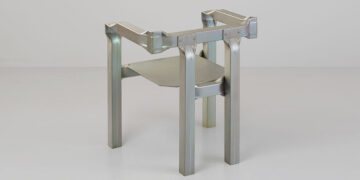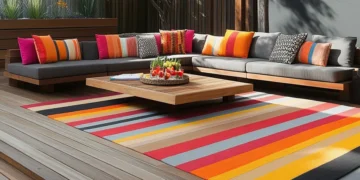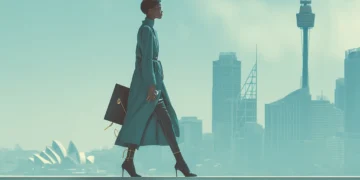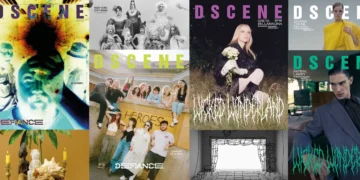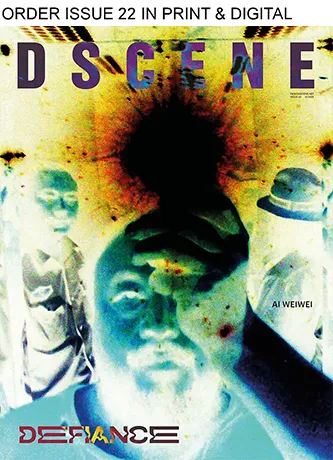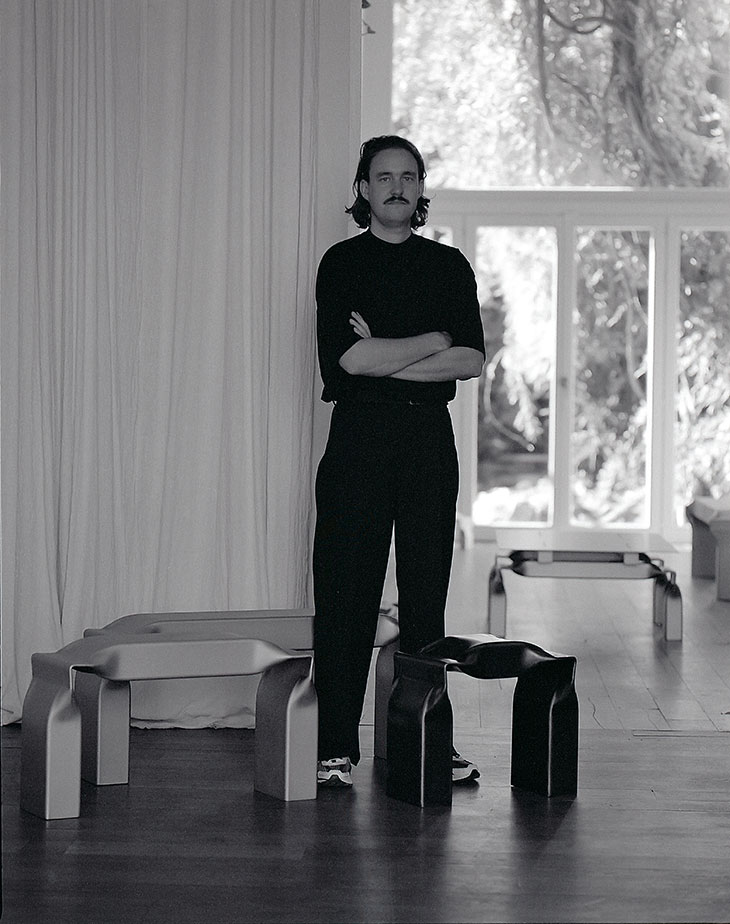
Tim Teven’s work is characterized by a hands-on, experimental approach that challenges conventional boundaries and embraces the unpredictability of creation. His Eindhoven-based studio serves as a laboratory for experimentation, where mechanical techniques are employed to deform metal into striking forms, resulting in a distinctive self-made aesthetic that captures the essence of both technical precision and artistic spontaneity.
DESIGN
Teven’s Tube Collection exemplifies this philosophy, showcasing a series of works born from rigorous material experiments that blur the lines between design and process. In this exclusive interview with DSCENE Magazine’s editor Katarina Doric, Teven invites us into his world—one where the act of making is just as vital as the final product, revealing the intricate dance between creativity and craftsmanship.

Tim, your approach to design is highly technical and material-driven. Could you share what initially inspired you to explore materials in such a hands-on, experimental way? – For me, this is a way of activating inspiration to experiment with materials and do unconventional things with them. In this way, I hope to surprise myself and find interesting outcomes or details that I can later translate into a piece. In my process, I react to the things I discover, and then I start thinking about what I can do with them or what they can become. I never sit down and design a chair on paper. Instead, I make material tests and then figure out that I can make a chair as a result, for example.

In your work, the production process often shapes the final design. How do you balance planning with spontaneous, process-led outcomes in your projects? – Most of the time, I create a system to work within. Every process or experiment also has its limitations. Once these limitations are noticed, they create a clear guideline of possibilities. This, combined with the use of shape and color/finish, creates a system in which I can design freely. The Tube Collection is a fantastic example of your ability to push materials to their limits.
If you do unconventional things with a material, there is a higher chance that you will discover something new.
Could you walk us through the process that led to this collection? – It’s basically the steps I described in the previous answers. The Tube Collection is my latest work, where I feel that this system is achieved perfectly. It started with my obsession with the deformation of metal (which is a leading factor in all of my work so far) and using one machine and one material to create a collection of works. This blurs the lines between designing every detail and allowing for spontaneous outcomes. The work shows an interplay between mechanical and handmade gestures.

Mechanical actions and material deformation play a key role in your designs. What challenges or discoveries have these techniques brought to your creative process? – So far, these techniques have led to all the discoveries and works I have made. They continue to fascinate me, and I am still experimenting with that principle right now.

How does working from your studio in Eindhoven influence your approach to craftsmanship and industrial design? – Eindhoven has a great creative environment. I have stayed here after my time at DAE to open my studio. The city has great studio spaces, making it a good place to start up. At this moment, I do not feel that the city is influencing me creatively that much, but it does make the operational side of the studio very convenient. Additionally, the Dutch Design Week plays a big role. This is where I first met Rossana Orlandi, and now we work together.
The deformed shapes and details that appear in my works are not pre-designed. They are a direct result of the process and the way I treat the material.
You mentioned a “self-made aesthetic” resulting from your technical gestures. How would you describe this aesthetic? – In a way, the deformed shapes and details that appear in my works are not pre-designed. They are a direct result of the process and the way I treat the material. So one could say that I did not design the shapes, but I designed the process. That’s what I mean by a self-made or ready-made aesthetic.

How important is functionality in your work, and where do you draw the line between function and form? – So far, function has always been a part of most of my works. I think I just like making functional pieces. It also creates a context around the works, making them more self-explanatory.
How do you see the role of designers evolving? – That’s a big question, haha. I think the general role of designers is to bring perspective to things other than the usual. The term “designer” is very broad, so this is difficult to summarize in one sentence. On the other hand, I think it’s also fine to create good-looking things and have fun while doing it. If the spectators enjoy it as well, it’s a win-win. Additionally, the industry surrounding designers is a big influence.

What can we expect from you for the upcoming MDW 2025? – I don’t know yet. Currently, I am extending the Tube Collection with new pieces and finishes. Alongside that, I will be working with another material. So, I guess MDW 2025 will be whatever comes out of that! 🙂
Keep up with Tim Teven on Instagram – @timteven_studio.
Tim’s work is now on display at Galleria Rossana Orlandi.
